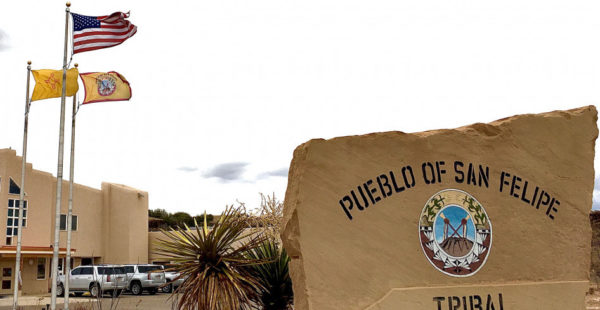
- Details
- By Native News Online Staff
SAN FELIPE PUEBLO — Three pueblos in New Mexico have become COVID-19 pandemic hotspots in Indian Country this week.
On Thursday, Pueblo of San Felipe Governor Anthony Ortiz described the situation on his pueblo as “dire within our community with positive COVID-19 cases” which are rising daily. As of yesterday, Ortiz said there were 54 positive cases on the Pueblo.
The Pueblo of San Felipe is 33 miles northeast of Albuquerque, N.M. The Pueblo of San Felipe consists of approximately 3,700 enrolled tribal members and approximately 68,000 acres.
“I cannot stress enough that everyone must adhere to the stay at home order that I issued recently. Stay at home order means to stay within the house that you currently live in. It does not mean it is ok to visit other relatives or friends residing in other homes,” Ortiz wrote on the pueblo’s website on Thursday.
Rep. Deb Haaland (D-N.M.) told KOAT Action News 7, an Albuquerque ABC affiliate, there were a few activities on the San Felipe pueblo where one infected person spread the virus around.
Haaland say while traditional and religious ceremonies are important, tribal citizens need to maintain proper social distancing.
"Some people might think we can still go to these gatherings, we can go to these activities, but that's how this thing gets spread,” Haaland said.
"Indian tribes were behind the eight ball with respect to the infrastructure, the health care, all of those things that we need, and then on top of it we have a pandemic," Haaland continued.
Two other pueblos that have been hit hard with coronavirus cases. The Pueblo of Zuni with 24 confirmed cases and one reported death; the other is the Zia Pueblo with 31 confirmed cases.
All three pueblos have implemented curfews for its residents.
On Wednesday, the Pueblo of Poroaque’s Hilton Santa Fe Buffalo Thunder, in Pojoaque, N.M., just north of Santa Fe began to offer rooms to serve as a temporary quarantine facility for New Mexico tribal citizens waiting for COVID-19 test results.
The largest hotspot in Indian Country is on the Navajo Nation where, as of Thursday night, there were 558 confirmed cases of COVID-19 and 22 deaths related to the deadly virus.
More Stories Like This
Native News Weekly (August 25, 2024): D.C. BriefsUS Presidents in Their Own Words Concerning American Indians
Native News Weekly (December 14, 2025): D.C. Briefs
Wounded Knee Massacre Site Protection Bill Passes Congress
Two Murdered on Colville Indian Reservation
Help us defend tribal sovereignty.
At Native News Online, our mission is rooted in telling the stories that strengthen sovereignty and uplift Indigenous voices — not just at year’s end, but every single day.
Because of your generosity last year, we were able to keep our reporters on the ground in tribal communities, at national gatherings and in the halls of Congress — covering the issues that matter most to Indian Country: sovereignty, culture, education, health and economic opportunity.
That support sustained us through a tough year in 2025. Now, as we look to the year ahead, we need your help right now to ensure warrior journalism remains strong — reporting that defends tribal sovereignty, amplifies Native truth, and holds power accountable.
 The stakes couldn't be higher. Your support keeps Native voices heard, Native stories told and Native sovereignty defended.
The stakes couldn't be higher. Your support keeps Native voices heard, Native stories told and Native sovereignty defended.
Stand with Warrior Journalism today.
Levi Rickert (Potawatomi), Editor & Publisher

